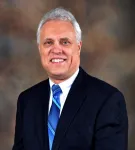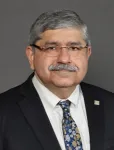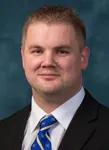(Press-News.org) The Gerontological Society of America (GSA) — the nation’s largest interdisciplinary organization devoted to the field of aging — has named 49 exemplary professionals as its newest fellows.
Fellow status is peer recognition for outstanding contributions to the field of gerontology and represents the highest category of GSA membership. This distinction comes at varying points in a person’s career and is given for diverse activities that include research, teaching, administration, public service, practice, and notable participation in the Society. Fellows are chosen from across GSA’s membership groups.
The new fellows will be formally recognized during GSA’s 2023 Annual Scientific Meeting, which will be held from November 8 to 12 in Tampa, Florida.
The Academy for Gerontology in Higher Education
Katarina Friberg-Felsted, PhD, FAGHE, University of Utah; Ramraj Gautam, PhD, FAGHE, University of Massachusetts Lowell
Behavioral and Social Sciences
Carolyn Adams-Price, PhD, FGSA, Mississippi State University; Lisa L. Barnes, PhD, FGSA, Rush University Medical Center; Monique J. Brown, PhD, MPH, FGSA, University of South Carolina; Michael Crowe, PhD, FGSA, University of Alabama at Birmingham; Tina Leigh Dothard Peterson, PhD, MSW, MPH, CSW, FGSA, The University of Cincinnati; Sam Fazio, PhD, FGSA, Alzheimer's Association; Eileen Graham, PhD, FGSA, Northwestern University; Tiffany F. Hughes, PhD, MPH, MBA, FGSA, Youngstown State University; Richard Ellis Kennedy, MD, PhD, FGSA, University of Alabama at Birmingham; Gloria Luong, PhD, FGSA, Colorado State University; Christine Armstrong Mair, PhD, FGSA, University of Maryland, Baltimore County; Wingyun Mak, PhD, FGSA, The New Jewish Home Research Institute on Aging; Shannon T. Mejía, PhD, FGSA, University of Illinois Urbana-Champaign; Lisa M. Soederberg Miller, PhD, FGSA, University of California, Davis; Chivon A. Mingo, PhD, FGSA, Georgia State University; Heehyul Esther Moon, PhD, MS, FGSA, University of Louisville; Dennis R. Myers, PhD, LCSW, FGSA, Baylor University; Amy Rauer, PhD, FGSA, University of Tennessee, Knoxville; Sudha Shreeniwas, PhD, FGSA, University of North Carolina Greensboro; Deborah M. Whitley, PhD, MPH, FGSA, Georgia State University; Lisa Ann Kirk Wiese, PhD, MSN, RN, GERO-BC, PHNA-BC, CNE, FGSA, Florida Atlantic University; Takashi Yamashita, PhD, MPH, MA, FGSA, University of Maryland, Baltimore County; Xin Zhang, PhD, FGSA, Peking University
Biological Sciences
Rich Allsopp, PhD, FGSA, University of Hawaii; Kylie Kavanagh DVM, MS, MPH, FGSA, Wake Forest University School of Medicine; Steven J. Prior, PhD, FGSA, University of Maryland, College Park
Health Sciences
Candace S. Brown, PhD, MA, Med, FGSA, University of North Carolina, Charlotte; Harleah G. Buck, PhD, RN, FPCN, FAHA, FGSA, FAAN, The University of Iowa; Thomas V. Caprio, MD, MPH, MS, FGSA, University of Rochester; Wen Liu, PhD, MSN, RN, FGSA, The University of Iowa; Jennifer M. Reckrey, MD, FGSA, Icahn School of Medicine at Mount Sinai; Debra Saliba, MD, MPH, AGSF, FGSA, UCLA Borun Center & VA Los Angeles GRECC; Elizabeth Vásquez, DrPH, FGSA, University at Albany (SUNY); Yu Doris Sau-fung RN, BSc(Nursing), PhD, FHKAN, FAAN, The University of Hong Kong; Oleg Zaslavsky, PhD, MHA, RN, FAAN, FGSA, University of Washington
Social Research, Policy, and Practice
Marc Cohen PhD, MPP, FGSA, University of Massachusetts Boston; Phyllis Cummins, PhD, FGSA, Miami University; Susan E. Hickman, PhD, FGSA, Indiana University; Su-I Hou, DrPH, MPH, BSN, CPH, MCHES, RN, CDP, FACHE, FGSA, University of Central Florida; Suk-Young Kang, PhD, MSSW, FGSA, Binghamton University; Christopher M. Kelly, PhD, FGSA, University of Nebraska at Omaha; R. Tamara Konetzka, PhD, FGSA, University of Chicago; Adria E. Navarro, PhD, LCSW, FGSA, University of Southern California; Nicole Ruggiano, PhD, MSW, FGSA, University of Alabama; April Temple, PhD, FGSA, James Madison University; Tiffany R. Washington, PhD, MSW, FGSA, University of Georgia; Ling Xu, PhD, FGSA, University of Texas at Arlington
###
The Gerontological Society of America is the nation's oldest and largest interdisciplinary organization devoted to research, education, and practice in the field of aging. The principal mission of the Society — and its 5,500+ members — is to advance the study of aging and disseminate information among scientists, decision makers, and the general public. GSA’s structure also includes a policy institute, the National Academy on an Aging Society.
END
LOS ALAMOS, N.M., June 26, 2023 — A groundbreaking theoretical proof shows that a technique called overparametrization enhances performance in quantum machine learning for applications that stymie classical computers.
“We believe our results will be useful in using machine learning to learn the properties of quantum data, such as classifying different phases of matter in quantum materials research, which is very difficult on classical computers,” said Diego Garcia-Martin, a postdoctoral researcher ...
Weill Cornell Medicine and Columbia University have been awarded a $9.8 million, five-year grant from the National Cancer Institute (NCI), part of the National Institutes of Health, to help combat cancer disparities fueled by persistent poverty.
The competitive award, will engage faculty members from Weill Cornell Medicine, Columbia University Mailman School of Public Health, Columbia University School of Nursing and SUNY Downstate Health Sciences University in a collaborative effort to develop a specialized research center and spearhead two large projects in ...
Chicago, Illinois (Embargoed until 9:30 am CDT, Monday, June 26, 2023)—Jean-Luc C. Urbain, MD, PhD, FASNC, professor of radiology/nuclear medicine and medicine, vice chair of theranostics, and director of nuclear medicine at Roswell Park Cancer Center at the University of Buffalo in New York, has been elected vice president-elect for the Society of Nuclear Medicine and Molecular Imaging (SNMMI). SNMMI introduced a new slate of officers during its 2023 Annual Meeting, held June 24-27.
“With the advent of new precision oncology nuclear therapies and the explosion of the field of theranostics, there has never been a more exciting ...
Chicago, Illinois (Embargoed until 9:30 am, CDT, Monday, June 26, 2023)—Umar Mahmood, MD, PhD, chief of Nuclear Medicine and Molecular Imaging, director of the Center for Precision Imaging, and associate chair for imaging sciences in the Department of Radiology at Massachusetts General Hospital and professor of radiology at Harvard Medical School in Boston, Massachusetts, has been named as the first recipient of the new Minoshima-Pappas Transformational Leadership Award. Mahmood was presented the award by the Society of Nuclear Medicine and Molecular Imaging (SNMMI) at its 2023 Annual Meeting.
The Minoshima-Pappas Transformational Leadership Award was ...
Chicago, Illinois (Embargoed until 9:30 am, CDT, Monday, June 26, 2023)—Peter J. H. Scott, PhD, associate professor of radiology and pharmacology, division director of nuclear medicine, and director of the PET Center at the University of Michigan in Ann Arbor, Michigan, has been named as the 2023 recipient of the Sam Gambhir Trailblazer Award. Scott was presented the award by the Society of Nuclear Medicine and Molecular Imaging (SNMMI) at its 2023 Annual Meeting.
Scott's nuclear medicine and molecular imaging research spans ...
Cambridge scientists have set out principles for how computational science – which powers discoveries from unveiling the mysteries of the universe to developing treatments to fight cancer to improving our understanding of the human genome, but can have a substantial carbon footprint – can be made more environmentally sustainable.
Writing in Nature Computational Science, researchers from the Department of Public Health and Primary Care at the University of Cambridge argue that the scientific community needs to act now if it is to ...
New research led by the University of East Anglia (UEA) reduces uncertainty in future climate change linked to the stratosphere, with important implications for life on Earth.
Man-made climate change is one of the greatest challenges facing us today, but uncertainty in the exact magnitude of global change hampers effective policy responses.
A significant source of uncertainty relates to future changes to water vapour in the stratosphere, an extremely dry region of the atmosphere 15–50 km above the Earth’s surface.
Future increases in water vapour here risk amplifying climate change and slowing down the recovery ...
The opioid crisis continues to pose a grave public health concern, with synthetic opioids such as fentanyl posing a major risk for development of addiction and death due to overdose. In a ground-breaking development, a recent study by the research group led by Prof. Ami Citri at the Hebrew University of Jerusalem's Edmond and Lily Safra Center for Brain Sciences has unveiled crucial insights into the brain's potential ability to regulate the urge to consume fentanyl. This discovery offers a glimmer of hope in the ongoing battle against ...
About The Study: Racial disparities in food insecurity were found among low-income households that do not participate in Supplemental Nutrition Assistance Program (SNAP) but not among those that do, suggesting that access to SNAP should be improved. These results also highlight the need to examine the structural and systemic racism in food systems and in access to food assistance that may contribute to disparities.
Authors: Laura J. Samuel, Ph.D., R.N., of the Johns Hopkins School of Nursing in Baltimore, is the corresponding author.
To access the embargoed study: Visit our For The Media website at this link https://media.jamanetwork.com/
(doi:10.1001/jamanetworkopen.2023.20196)
Editor’s ...
Pioneering analysis of deep-sea corals has overturned the idea that ocean currents contributed to increasing global levels of carbon dioxide in the air over the past 11,000 years.
The study, led by the University of Bristol in the UK and Nanjing University in China, examined historic deep-sea corals to shed intriguing new light on the history of ocean chemistry.
Understanding what has led to the pre-industrial rise in carbon dioxide (CO2) levels during the Holocene period, which dates back some 11,700 years to the present day, is a source of scientific debate. One theory suggests the increase in physical ...



